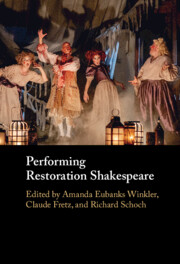Book contents
- Performing Restoration Shakespeare
- Performing Restoration Shakespeare
- Copyright page
- Contents
- Figures
- Tables
- Music Examples
- Notes on Contributors
- Foreword
- Acknowledgements
- Abbreviations
- Introduction: New Shakespeare for a New Era
- Chapter 1 From Boards to Books: The Circulation of Shakespearean Songs in Manuscript and Print during the Interregnum
- Chapter 2 Heroic Shakespeare at Lincoln’s Inn Fields
- Chapter 3 More than a Song and Dance? Identifying Matthew Locke’s Incidental Music for Macbeth
- Chapter 4 Cross-Dressing in Restoration Shakespeare: Twelfth Night and The Tempest
- Chapter 5 Performing Restoration Shakespeare in the Eighteenth Century
- Chapter 6 An Actor’s Perspective on Restoration Shakespeare
- Chapter 7 Staging Restoration Shakespeare with Restoration Music
- Chapter 8 Davenant’s Lady Macduff and the Subversion of Normative Femininity in Twenty-First-Century Performance
- Chapter 9 Facts as Ideas: The Theatricalisation of Scholarship
- Chapter 10 Syncopated Time: Staging the Restoration Tempest
- Bibliography
- Index
Chapter 4 - Cross-Dressing in Restoration Shakespeare: Twelfth Night and The Tempest
Published online by Cambridge University Press: 28 January 2023
- Performing Restoration Shakespeare
- Performing Restoration Shakespeare
- Copyright page
- Contents
- Figures
- Tables
- Music Examples
- Notes on Contributors
- Foreword
- Acknowledgements
- Abbreviations
- Introduction: New Shakespeare for a New Era
- Chapter 1 From Boards to Books: The Circulation of Shakespearean Songs in Manuscript and Print during the Interregnum
- Chapter 2 Heroic Shakespeare at Lincoln’s Inn Fields
- Chapter 3 More than a Song and Dance? Identifying Matthew Locke’s Incidental Music for Macbeth
- Chapter 4 Cross-Dressing in Restoration Shakespeare: Twelfth Night and The Tempest
- Chapter 5 Performing Restoration Shakespeare in the Eighteenth Century
- Chapter 6 An Actor’s Perspective on Restoration Shakespeare
- Chapter 7 Staging Restoration Shakespeare with Restoration Music
- Chapter 8 Davenant’s Lady Macduff and the Subversion of Normative Femininity in Twenty-First-Century Performance
- Chapter 9 Facts as Ideas: The Theatricalisation of Scholarship
- Chapter 10 Syncopated Time: Staging the Restoration Tempest
- Bibliography
- Index
Summary
This chapter analyses cross-dressing in Restoration Shakespeare – in the main, female characters dressed in male attire – exploring the key question of how this theatrical device was influenced by the advent of the professional actress on the English stage. The approach is twofold. Firstly, the chapter examines the use of cross-dressing in specific Restoration-era adaptations of Shakespeare. One of the earliest of these, Dryden and Davenant’s The Tempest (1667), provides additional opportunities for transvestite performance as the play’s new male role of Hippolito was performed as a travesty part by an actress (either Mary Davis or Jane Long) and the female part of Sycorax (also added to the play by the adapters) was likely played by a man. Furthermore, it explores how other adapters treated the cross-dressing already inherent in the Shakespearean texts they chose to rewrite, considering, for example, George Granville’s The Jew of Venice (1701) and Charles Burnaby’s Love Betrayed (1703), a version of Twelfth Night. Secondly, the chapter investigates the Restoration performance history of Shakespearean ‘originals’ that feature transvestism, including Twelfth Night and The Merry Wives of Windsor. The chapter nuances our understanding of gender in Restoration Shakespeare through a detailed consideration of cross-dressing.
Keywords
- Type
- Chapter
- Information
- Performing Restoration Shakespeare , pp. 79 - 96Publisher: Cambridge University PressPrint publication year: 2023



